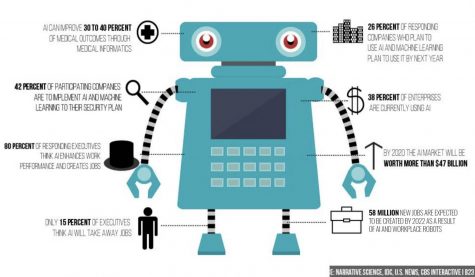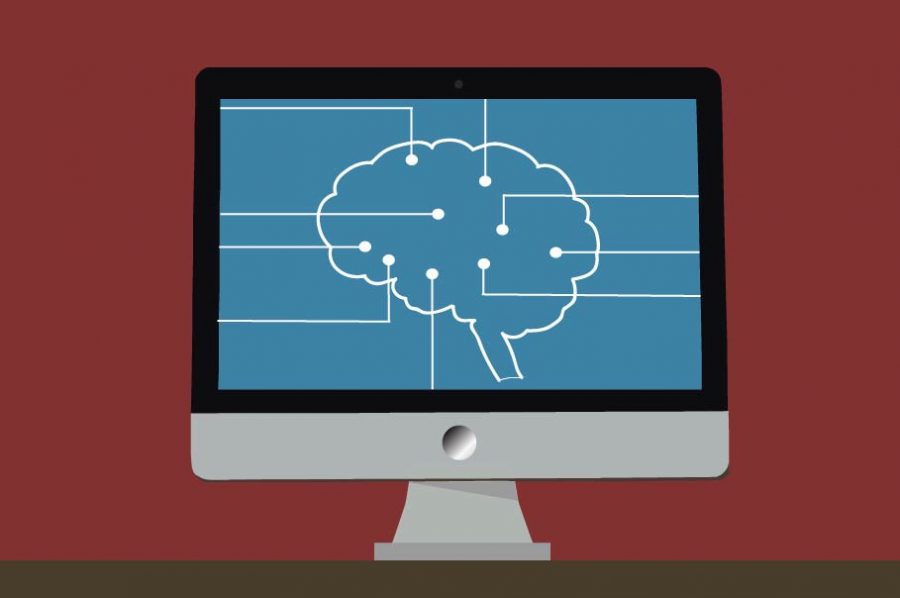Artificial intelligence is one of the fastest growing technologies in today’s age. As it progresses, more debates have arisen concerning the safety and true potential of AI. Graphic by Cristina Gomez.
Venturing into the era of artificial intelligence: humanity’s doom or greatest ally? (Part 1)
February 1, 2020
From portable virtual reality headsets to self-landing space rockets, new technological advancements are popping up right and left in today’s age. However, among the expanding sea of innovation, the one technology that will most likely influence the future is artificial intelligence (AI).
AI, defined as the science of computers mimicking human intelligence, often presents itself in the form of fantastical science-fiction robots and programs in pop culture, such as Tony Stark’s JARVIS interface or Wall-E. When asking the general public, many see AI as something futuristic and unworldly. But in fact, AI could be closer to reality than many may believe.
Over the years, the public has developed diverse views on AI. Some claim the positive potential of it outweighs any possible consequences, while others urge caution and even go as far as to call it humanity’s doom. One thing most experts agree on is that AI is going to be a critical part of a U.S. citizen’s everyday life in the coming decades.
Though not always visible to the eye, AI has already planted itself in parts of everyday life, from tailoring Instagram feeds and improving smartphone cameras to choosing what ads one sees and filtering email inboxes of spam emails.
Studies predict AI could contribute about $13 trillion to the global economy by 2030, causing the global GDP to increase 1.2% annually. This technology is already shaking up economies, pushing companies to adapt and forcing the public to acknowledge its colossal potential.
But with the arrival of AI, a glaring question has been pushed out into the open. Will this blur of ones and zeros become humanity’s Frankenstein? Or will it become what the wheel was to the early man?

British Google-owned AI development company Deepmind, often regarded as one of the fastest developing AI businesses, is focused on pushing the boundaries of AI. Deepmind made headlines five years ago with the creation of various AI powered “agents” with diverse bodies, such as a spider or a humanoid shape for example, whose sole purpose was to traverse different virtual terrains.
The agents were required to learn how to walk, jump and turn all without receiving instructions or human interference. Though there was initially a steep learning curve, slowly but surely, the agents perceived their surroundings and taught themselves to cleverly propel themselves through the obstacles. This experiment demonstrates how AI functions: it tries, it fails, it learns and most importantly, it adapts.
AI has been used more and more frequently in discussions about smart cities. The Coppell Vision 2040 plan, created by research and consulting company Future iQ, made sure to include AI in its aim to make Coppell a smart city.
Future iQ plans to implement AI into Coppell businesses, education and other areas in its Coppell Vision 2040 plan. One proposal is to use AI to set up a system of autonomous transit traversing the city.
Future iQ CEO David Beurle and Coppell community projects manager Molly Bujanda played a big part in the formation of the Coppell 2040 plan.
“I was recently at a workshop in Wisconsin where I met [Brad] Smith, the president of Microsoft,” Beurle said. “He said if you look at the previous century, the defining technology that really brought in the biggest industrial transformation was the internal combustion engine. The technologies that came from the internal combustion engine led to automobiles, airplanes and more… The way you relate to it is that artificial intelligence is a simple route to adopt technology that’s going to lead to the next significant life transformation.”
It would not be like the “Johnny Cab” taxis from the 1990 dystopian film Total Recall or fleets of large autonomous buses. Rather, it would be petite shuttles that follow predetermined routes based on popular community spots and business destinations.
“It’s very aspirational,” Bujanda said. “It really challenged the public to think further into the future and where we are today. One of the things that David [Beurle] and Future iQ did a good job of educating the public about was some technologies that are inevitable on the horizon and how do we get ahead of those. Autonomous vehicles is one of those, but we want to be prepared for an open mind.”
Larger cities such as Portland, Ore. have already opened their streets to driverless cars. Another similar example can be found right in Coppell’s neighboring cities.
In late 2018, Drive.ai, an autonomous vehicle program hailing from Silicon Valley, set up a fleet of AI-run, self-driving taxis for citizens hosted by the City of Frisco. The prototype system was a success, transporting nearly 5,000 unique users with no accidents. It closed up shop in Frisco last March and is expected to start up in Arlington very soon.
Commercial air travel is yet another field that is, perhaps unbeknownst to most, dependent on AI technology. In fact, The New York Times reports the average flight of a Boeing plane involves only seven minutes of human-steered flight, which is typically reserved only for takeoff and landing.
The IBM Watson AI is a supercomputer that uses both artificial intelligence and analytical software to function as a “question answering” machine and is one of the front runners in the field of AI. Watson can achieve some tasks that would take a human weeks to compete in a matter of seconds; for example, an average doctor reads about a half-dozen medical research papers in a month, whereas Watson can read, memorize and understand half a million papers in about 15 seconds.
And though the IBM Watson may currently be one of the most powerful and capable AIs, it is still in its developing stages.

The business world is quickly recognizing the potential of artificial intelligence and how beneficial it could prove to be in its commerce.
Instances such as these show the nimble, yet substantial, power of AI as it finds ways to break into any industry thanks to its very versatile nature. Today, almost all the major technology corporations have a hand in the AI development, and companies from all over the industry spectrum are rapidly adopting it into their businesses.
“AI is going to be incredible for [engineering],” Coppell High School STEM teacher Mike Yakubovsky said. “It will offer a lot of new opportunities, change the way people work and change the types of jobs people do. It will offer us the ability to do things we could never have been done before. There will be a lot of changes with AI, and a lot of adjustment and growth and figuring out how to deal with it. It’s going to be huge for engineering and computer science.”
This story is part of a four-part news feature package. Click here to see part two, three and four.

